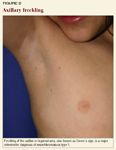More than skin deep: Cutaneous signs of systemic disease
What you see on the outside can provide valuable clues that all is not well on the inside. Here are some important signs to watch for.
The skin, considered the largest organ of the human body, is often a visual indicator of underlying disease. Both general pediatricians and specialists must be able to recognize certain suggestive cutaneous findings to evaluate and counsel patients appropriately. Early recognition of the skin signs of systemic disease can be critically important-even lifesaving. This review considers selected neurocutaneous disorders, autoimmune diseases, nutritional deficiencies, and vascular anomalies that are often first recognized based on their cutaneous manifestations.



Although neurofibromas do not usually appear before 5 years of age, at least 90% of patients develop the lesions by 20 years of age. Plexiform neurofibromas, which are soft, large, and not well circumscribed, often become clinically obvious by 2 years. Unexplained pain in conjunction with enlargement of a neurofibroma and a focal neurologic deficit should prompt a workup for neurofibrosarcoma.
Another important cutaneous finding to watch for is juvenile xanthogranulomas (JXGs). These yellowish papules or nodules can appear anywhere on the body but more often occur on the head, neck, and upper trunk. A JXG in a child with NF indicates an increased risk of chronic myeloid leukemia, although this is a rare phenomenon.1
A patient suspected of having NF-1 should be examined for pulsating exophthalmos, which indicates sphenoid wing dysplasia-a rare change in the sphenoid bone of the skull that is considered to be highly characteristic of NF-1. Also, check head circumference for macrocephaly-which may be benign or indicate intracranial pathology, such as an optic glioma-and evaluate the patient for scoliosis. Blood pressure should be measured periodically for hypertension, which can result from renovascular disease or pheochromocytoma.2
Ophthalmologic examination is recommended to evaluate for Lisch nodules or optic gliomas. Lisch nodules, also called iris hamartomas, are rare in infants but appear in early childhood. They are present in as many as 95% of adults with NF-1. They do not interfere with vision. Lisch nodules can help establish a diagnosis of NF-1 in a patient with multiple CALMs. Optic gliomas usually appear by the age of 5 years.
Recognize & Refer: Hemangiomas in pediatrics
July 17th 2019Contemporary Pediatrics sits down exclusively with Sheila Fallon Friedlander, MD, a professor dermatology and pediatrics, to discuss the one key condition for which she believes community pediatricians should be especially aware-hemangiomas.